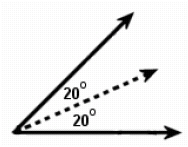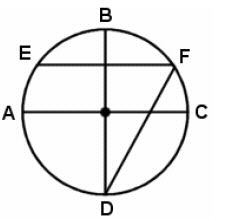Multiple Choice
Identify the choice that best completes the
statement or answers the question.
|
|
|
1.
|
Algebraic Concepts – Patterns, Sequences,
Functions – RIT 241 – 250
Given the following sequence 1, 4, 9, 16, 25 . .
.
What is the eighth term of this sequence?
|
|
|
2.
|
Which set of ordered pairs is a function?
a. | { (2,3), (3,4), (4,5), (3,5), (6,3) } | d. | { (2,3), (3,3), (4,3), (2,4), (6,3)
} | b. | { (2,3), (3,3), (4,3), (5,3), (6,3) } | e. | { (2,3), (3,4), (4,5), (5,6), (2,6)
} | c. | { (2,3), (2,4), (3,4), (4,5), (5,6) } |
|
|
|
3.
|
Which table represents an example of inverse variation?
|
|
|
4.
|
Algebraic Concepts – Solving Equations
& Inequalities – RIT 241 – 250
Solve for x: x2 + 4 =
20
a. | x = 4 and x = -4 | c. | x = 3 and x = -3 | b. | x = - 5 and x = 5 | d. | x = 2 and x =
-2 |
|
|
|
5.
|
Give the slope of a line perpendicular to the line represented by the
equation
3x + 5y = 15
|
|
|
6.
|
Solve the following system of equations and interpret the solution
graphically.
2x – 3y = 6
x + y = 8
a. | (6,0), lines intersect | d. | (6,2), lines intersect | b. | (-6,6), lines parallel | e. | (-6,-2), lines parallel | c. | (6,6), same
line |
|
|
|
7.
|
Find the x and y intercepts for the linear equation 7x – 2y + 14 =
0.
a. | (-2,0) (0,7) | d. | (-7,0) (0,2) | b. | (7,0) (0,-2) | e. | (-2,0) (0,-7) | c. | (2,0)
(0,-7) |
|
|
|
8.
|
|
|
|
9.
|
Computation – Fractions – RIT 241
– 250
6 X 1 3/5 =
a. | 6 3/5 | d. | 4 4/5 | b. | 9 3/5 | e. | 3 3/5 | c. | 3
3/4 |
|
|
|
10.
|
Computation – Integers – RIT 241
– 250
Put the following integers in order from least to
greatest.
a. | -4, 3, -2, 0, 2 | d. | –4, -2, 0, 2, 3 | b. | 0, -2, 2, 3,
-4 | e. | –4, 3, 2, -2,
0 | c. | –2, -4, 0, 2, 3 |
|
|
|
11.
|
–5 - (-9) =
|
|
|
12.
|
Geometry – Properties and Terminology
– RIT 241 – 250
Complete the statement with the correct
answer.
Parallel lines are . . .
a. | in the same plane and do not intersect. | c. | in different planes and do not
intersect. | b. | in the same plane and do intersect. | d. | in different planes and do
interact. |
|
|
|
13.
|
a. | an angle bisector | d. | a segment bisector | b. | a supplementary | e. | a perpendicular bisector | c. | a right
angle |
|
|
|
14.
|
 Find the length of the missing side.
|
|
|
15.
|
 The dashed line represents . . . a. | an angle bisector | c. | an altitude | b. | a perpendicular bisector | d. | a hypotenuse |
|
|
|
16.
|
 Which two chords in the diagram have the same
length? a. | BD and AC | d. | FD and AC | b. | EF and BD | e. | FD and BD | c. | EF and
AC |
|


